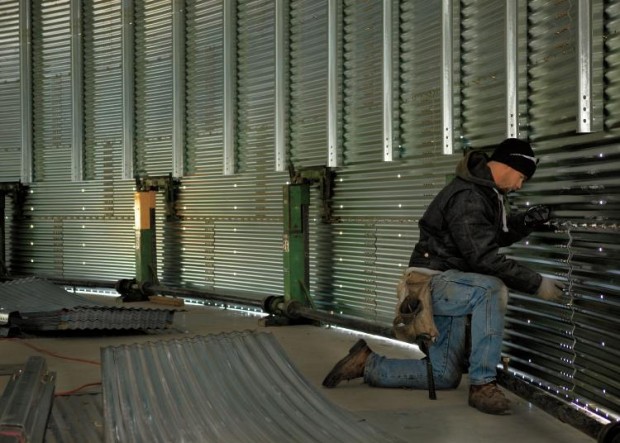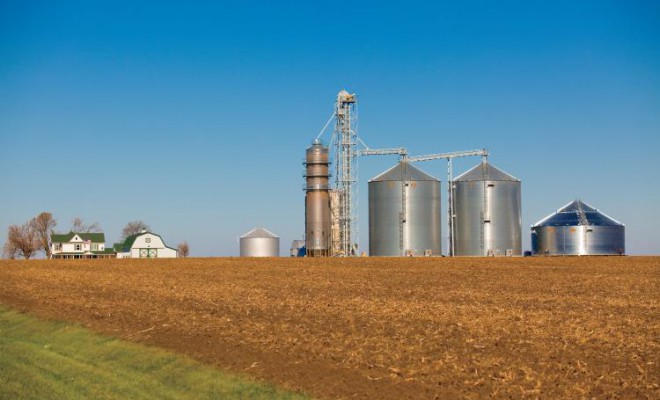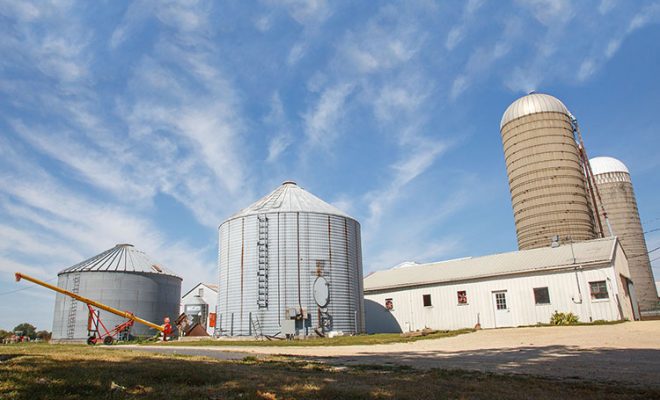
Those silver, corrugated steel cylinders with domed tops seem to be sprouting from Illinois farmland.
Properly, they’re called bins, the most common storage structure for the state’s two major crops – corn and soybeans. And if they seem shinier and bigger than their counterparts, they probably are. New bins pace with the productivity of family farms, which have grown in size and can produce about 35 percent more corn per acre than 20 years ago. With farmers using higher-capacity equipment for harvesting and hauling crops, small storage bins can’t keep up with the harvest routine.
Just ask farmer Andy Pratt near Dixon, where his family added a third, 83-foot-tall bin to their farm a few months ago.
“The main reason we did this is for efficiencies during harvest,” says Andy, a fourth-generation farmer who grows field corn, soybeans and seed corn with his father, Michael, and brother, Peter. “Now that we’re able to do this, my dad, brother and I can harvest without any employees.”
Their farm semi-truck can unload its 950 bushels of corn in less than a minute, which means the truck can return more quickly to the field for another fill. [Related: Hawes Grain Elevator Museum in Atlanta, Illinois]
Farmers increasingly desire to have as much control over their harvest schedule as Mother Nature will allow. After all, it is the crop that pays the bills. A majority of farmers own bins, whether new or old, big or small, and haul whatever crop they cannot store themselves to local elevators in the business of storing the crops.
But in the last five years, the bin-building business has jumped with the demand for corn, says Bob Rasmus, marketing manager of grain systems for GROWMARK Inc.
To harvest corn beyond the hours an elevator may operate, more farmers like the Pratt family update their own storage, which is close to home and available 24 hours a day.

Basic Bins
New bins today look industrious and complicated, but in reality their design is about as simple as storing a tractor in a shed. Besides getting bigger, bins have changed little structurally since their introduction, Rasmus says. However, new ones have improvements: Bins today are safer, with caged ladders, platforms and stairs to climb them. Grain quality is more easily maintained with improved air movement and grain temperature monitoring devices, he says.
Some of the earliest grain bins appeared in the 1970s, Rasmus says. Before that, farmers generally picked corn by the ear and stored it in corncribs, which includes those wooden slatted structures aging on some farms today. The bin debuted when harvesting machines, or combines, could pick the corn and shell it, which created a need to store kernels instead of ears.
The Pratts built their first grain bins in the early 1980s. That storage served its purpose for the time, at 100,000 bushels, collectively, and they still use it today. Their new bins dwarf those and hold six times more corn. That’s equivalent to slightly more than 600 semi-truckloads of corn.
Generally, a drive through farm country will surface two types of storage set-ups: big bins with lots of pipes and smaller bins without such things. Basically, the larger systems require stationary devices for moving grain in and out. The smaller often use portable equipment.
Drive past the Pratts’ farm, and you would see three big bins, central towers and pipes. The bins are 83 feet tall and range from 60 to 78 feet in diameter. One of the center towers is a 95-foot-tall dryer. It’s skinny by comparison to the bins and will dry corn for storage. Farmers dry corn to remove moisture and prevent spoilage until the corn is sold. The tallest tower at 130 feet is a “leg,” which lifts grain to a high point to flow through those pipes that connect to each bin.
What you don’t see from the passenger seat is a scale to weigh a semi and its load. Nor would you notice the below-ground pit where the belly of the truck dumps the crop, which then is elevated to the dryer or storage bin. And inside each bin is that temperature technology Rasmus talks about: a series of temperature cables that hang from the roof of the bins and through the grain mass. This warns Pratt of any threats to crop quality – issues that could threaten his family’s livelihood.





It’s good to know that grain bins are becoming more popular among rural communities. My wife and I want to start farming. We’ll look further into grain storage moving forward! http://www.mnmillwright.com/